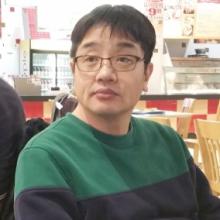Senior Research Scientist

I have the expertise, training, and knowledge to accomplish the proposed research project. I have a broad background in multidisciplinary areas of molecular biology, protein engineering, chemical biology, nanobiotechnology, and glycobiology. Specific areas of current research include (1) the development of high-throughput and high-content imaging (HCI) assays to screen drug candidates, evaluate drug toxicity, and identify the function of target proteins; (2) the development of biochemical and molecular biology-driven assays, including immunohistochemistry, RNAi, reporter gene assays, CRISPR-Cas9 systems, and proteinprotein interactions; (3) the application of combinatorial methods to the generation of small molecules (natural products) and macromolecules (proteins, nucleic acids, and carbohydrates) with novel properties; (4) the development of highly sensitive assays for detecting glycansprotein interactions; (5) the design of multivalent antiviral nanostructured inhibitors; (6) Design DNA Origami-based biosensors, inhibitors and protein delivery vehicles. Thus, I have hands-on experience in cell-based HCI design, microarray bioprinting, glycan-DNA conjugations, multivalent interactions, protein-nanoparticle interactions, and glycan-protein interactions. Since 2005 at Rensselaer Polytechnic Institute (RPI), I have made important contributions to many interdisciplinary applications, including constructing recombinant viruses for metabolism-induced toxicity assays, including adenoviruses carrying genes for drug metabolizing enzymes (DMEs) as well as lentiviruses carrying sgRNAs for expressing DMEs in hepatic cell types. As a research scientist at RPI, I have proposed, planned, scheduled and executed the aforementioned projects. Additionally, I have > 50 publications including papers in prestigious peer-reviewed journals (such as Nature Communications, Nature Nanotechnology, and ACS Nano), book chapters, and patents (See my selected publication listed below).
Education and Training
Post Doc (2012) in Chemical/Biological Engineering, Rensselaer Polytechnic Institute
Post Doc (2004) in Cancer Research, University of Pittsburg Medical Center
Post Doc (2003) in Metabolic Engineering, University of Minnesota
Sr. Scientist (2002) in Biotechnology, Genofocus
Post Doc (2000) in Applied Microbiology KRIBB
Ph. D. (1998. 2) Dept. of Biological Sciences, Korea Advanced Institute of Science and Technology (KAIST), South Korea, Biocatalysis and Bioengineering (Prof. Joon Shick Rhee)
Dissertation: Application of Pervaporation to Lipase-Catalyzed Esterification in Organic Solvent.
M. S. (1994. 2) Korea Advanced Institute of Science and Technology (KAIST), Dept. of Biotechnology, South Korea, Biocatalysis and Biotransformations (Prof. Joon Shick Rhee)
Dissertation: Enzymatic Synthesis of Mono-, or Diacylglycerol in Organic Solvent.
B. S. (1992. 2) Yonsei University, Dept. of Food Engineering, South Korea (Prof. Chul Soo Shin)
Research Interests
1. Development of high-throughput and high-content imaging assays to screen drug candidates, evaluate drug toxicity, and identify the function of target proteins: Combining bioimaging tools with 3D cell culture in microchip formats can accelerate the pace of drug development and also provide insightful knowledge of cell development, morphogenesis and physiological change, resulting in translating into novel clinical applications. In addition, it is becoming increasingly clear that 2D screening platforms do not effectively mimic the 3D environment found in vivo, and as a result, significant differences in cellular responses to drugs, drug candidates, and chemicals may result in reduced predictability of in vitro surrogates to human outcomes. Thus, we has developed microchipbased 3D cell culture platform. With this technology we can rapidly identify candidate genes that may underlie phenotypes of interest in mammalian cells (e.g. tube formation) as well perform drug screening. To create 3D cell culture microarrays, Lego-like a complementary arrangement of micropillar and microwell structures prepared by plastic injection molding, which is ideal for mammalian cell culture, enzymatic reactions, viral transduction and highthroughput screening. Using this approach we have locally introduced into mammalian cells cDNAs and shRNAs with adenoviruses or lentiviruses as well as small molecules. We can examine the cells for alterations in particular phenotypes using techniques compatible with cells growing on the surface of micropillar chip, such as immunofluorescence or in situ hybridization or promoter-reporter assay.
- Joshi, P., Yu, K. N., Kang, S. Y., Kwon, S. J., Kwon, P. S., Dordick, J. S., Kothapalli, C. R., Lee, M. Y. 3D-cultured neural stem cell microarrays on a micropillar chip for high-throughput developmental neurotoxicology. Exp Cell Res. 370, 680 (2018). PMID: 30048616
- Kwon, S. J., Lee, D. W., Shah, D. A., Ku, B., Jeon, S. Y., Solanki, K., Ryan, J. D., Clark, D. S., Dordick, J. S., Lee, M. Y. High-Throughput and Combinatorial Gene Expression on a Chip for Metabolism-Induced Toxicology Screening. Nat. Commun. 5, 3739 (2014). PMCID: PMC4132844
- Fernandes, T. G., Kwon, S. J., Lee, M. Y., Diogo, M. M., Clark, D. S., Cabral, J. M. S., and Dordick, J. S., Three-Dimensional Cell Culture Microarray for HighThroughput Studies of Stem Cell Fate. Biotechnol. Bioeng. 106, 106-118 (2010). PMID: 20069558.
- Fernandes, T. G., Kwon, S. J., Lee, M. Y., Clark, D. S., Cabral, J. M. S., Dordick, J. S. (2008) On-Chip, Cell-Based Microarray Immunofluorescence assay for HighThroughput Analysis of Target Proteins. Anal. Chem. 80:6633-9. PMID: 18656951
2. Application of multivalent interactions for combating infectious diseases and modulating cell signaling: Ligands, including peptides, proteins, aptamers, and glycans serve a critical role in cell-cell communication and function through their interaction with other biomolecules, such as proteins. Specially, glycan-biomolecule interaction has several unique features, including high specificity, low avidity, multi-valency, high on-rates/off-rates of binding and responsiveness to environmental changes. We have designed the controllable and biocompatible multivalent nanoparticles for combating influenza virus infection. In addition, we have developed sensitive detection methods of glycan-biomolecule interaction, which may be useful tool to not only identify virus or toxin molecules but also decipher the signal pathway modulated by specific GAG molecules.
- Kwon, S. J., Na, D. H., Kwak, J. H., Douaisi, M., Zhang, F., Park, E. J., Park, J. H., Youn, H., Song, C. S., Kane, R. S., Dordick, J. S., Lee, K. B., Linhardt, R. J. Nanostructured glycan architecture inhibits influenza A virus infection. Nat. Nanotechnol. 12:48-54 (2017) PMID: 27775724.
- Kwon S. J., Jeong, E. J., Yoo, Y. C., Yang, G. H., Lee, J. C., Dordick, J. S., Linhardt, R. J., Lee, K. B. High Sensitivity Detection of Active Botulinum Neurotoxin (BoNT) by Glyco-qPCR. Anal. Chem. 86, 2279-84 (2014). PMCID: PMC3985614
- Sterner, E., Meli, L., Kwon, S. J., Dordick, J. S., Linhardt, R. J. FGF-FGFR Signaling Mediated through Glycosaminoglycans in Microtiter Plate and Cell-Based Microarray Platforms. Biochemistry 52, 9009-9019, (2013). PMCID: PMC3901155.
- Kwon, S. J., Lee, K. B., Solakyildirim, K., Masuko, S., Ly, M., Zhang, F., Li, L., Dordick, J. S., Linhardt, R. J. Signal Amplification by Glyco-qPCR for Ultrasensitive Detection of Carbohydrates: Applications in Glycobiology. Angew. Chem. Int. Ed. 51, 11800 - 11804 (2012). PMCID: PMC3544480.
3. Design of protein-nanoparticle conjugates for combating bacterial pathogens: Bacterial infections remain a major public health concern. However, broad-spectrum antibiotics largely target redundant mechanisms of bacterial survival and lead to gained resistance owing to microbial evolution. New methods are needed to attack bacterial infections. Enzymes offer one such weapon, and their diversity has been exploited to kill bacteria selectively through unique targets, particularly in bacterial cell walls, as well as nonselectively through generation of bactericidal molecules. In both approaches, microbial resistance has largely been absent, which bodes well for its potential use in human therapeutics. Furthermore, enzyme stabilization through conjugation to nanoscale materials and incorporation into polymeric composites enable their use on surfaces to endow them with antimicrobial properties. To this ends, we have used antimicrobial enzyme-containing nanocomposites to biomedical applications, environmental decontamination and antifouling, food packaging and processing.
- Kwon S. J., Kim D., Lee I., Nam J., Kim J., Dordick J. S. Sensitive multiplex detection of whole bacteria using self-assembled cell binding domain complexes. Anal. Chim. Acta. 1030:156-165. (2018) PMID: 30032765
- Kim D., Kwon S. J., Wu X., Sauve J., Lee I., Nam J., Kim J., Dordick J. S. Selective Killing of Pathogenic Bacteria by Antimicrobial Silver Nanoparticle-Cell Wall Binding Domain Conjugates. ACS Appl Mater Interfaces. 10:13317-13324. (2018) PMID: 29619821
- Wu X., Kwon S. J., Kim J., Kane R. S., Dordick J. S. Biocatalytic Nanocomposites for Combating Bacterial Pathogens. Annu. Rev. Chem. Biomol. Eng. 8:87-113. (2017) PMID: 28592177
- Kwon S. J., Kim D., Lee I., Kim J., Dordick J. S. In vitro gene expression-coupled bacterial cell chip for screening species-specific antimicrobial enzymes. Biotechnol. Bioeng. 114:1648-1657 (2017) PMID: 2836969
4. Development of combinatorial methods to the generation of small molecules (natural products) and macromolecules (proteins, nucleic acids, and carbohydrates) with novel properties: The enormous pool of chemical diversity found in nature serves as an excellent inventory for accessing biologically active compounds that is unsurpassed by any synthetic libraries. About 40% of the chemical scaffolds found in natural products are absent in today’s medicinal chemistry repertoire. Advances in DNA sequencing technology, genome mining, and microbial metagenomic research provide a powerful toolbox to identify natural product biosynthetic pathways and open up a vast portion of the unexploited natural product ‘space’. In vitro pathway reconstruction can be used to characterize individual pathway enzymes, identify pathway intermediates, and gain an increased understanding of how pathways can be manipulated to generate natural product analogs. Moreover, through in vitro approaches, it is possible to achieve a diversification that is not restricted by toxicity, limited availability of intracellular precursors, or preconceived (by nature) regulatory controls. Additionally, combinatorial biosynthesis and high-throughput techniques can be used to generate both known natural products and analogs that would not likely be generated naturally.
- Kwon, S. J., Mora-Pale, M., Lee, M. Y., Dordick, J. S. Expanding Nature's Small Molecule Diversity via In vitro Biosynthetic Pathway Engineering. Curr Opin Chem Biol. 16,186-195 (2012). PMID: 22397884.
- Kwon, S. J., Kim, M. I., Ku, B., Coulombel, L., Kim, J. H., Shawky, J. H., Linhardt, R. J., Dordick, J. S. Unnatural Polyketide Analogs Selectively Target the HER Signaling Pathway in Human Breast Cancer Cells. ChemBioChem 11, 573-580 (2010). PMCID: 3094853
- Kim, M. I., Kwon, S. J., Dordick, J. S. In vitro Precursor-Directed Synthesis of Polyketide Analogues with Coenzyme a Regeneration for the Development of Antiangiogenic Agents. Org. Lett. 11, 3806-3809 (2009). PMCID: PMC2745566.
- Kwon, S. J., Lee, M. Y., Ku, B., Sherman, D. H., Dordick, J. S. In vitro Metabolic Pathway Engineering for Natural Product Drug Discovery. ACS Chem. Biol. 2, 419425 (2007). PMID: 17530734.
Publications
Full list of publications on Google Scholar.
Awards
- Research Fellowship Award from Korea Science and Engineering Foundation (KOSEF) 1998-1999
- The American Oil Chemists' Society (AOCS) Award in U.S.A. 1996-1997
- Oh-Woon Scholarship (KOLON Inc.) in Korea 1990-1992
